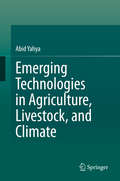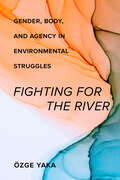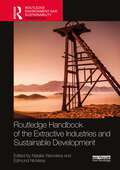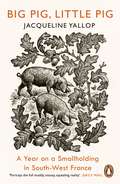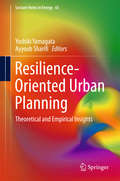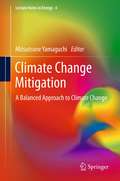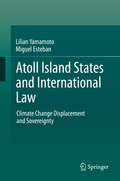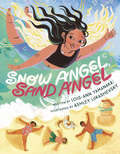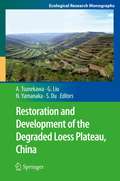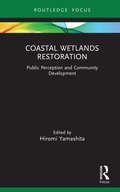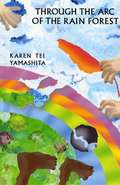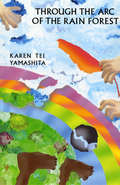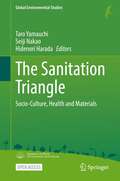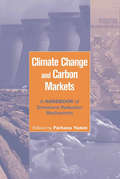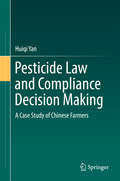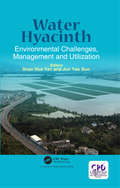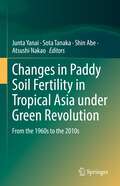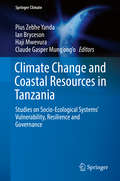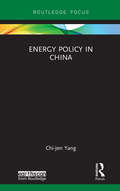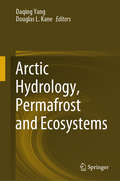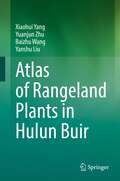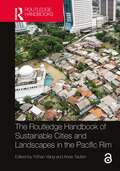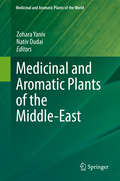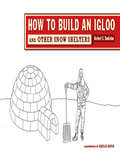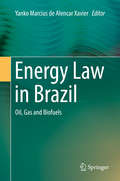- Table View
- List View
Emerging Technologies in Agriculture, Livestock, and Climate
by Abid YahyaThis book provides applications of wireless sensor networks (WSN) in environmental monitoring, with an emphasis on livestock disease detection and agricultural management in Africa to aid farmers. This proposed system entails current and innovative monitoring technologies intended to improve agricultural conditions in Africa, with a focus on Botswana, and addresses the Internet of Things (IoT) as a set of remote monitoring protocols using WSNs to improve and ensure proper environmental maintenance. In this book, the author introduces WSNs, and how the IoT can be applied to develop a system of "smart agriculture" in Africa, taking into account livestock health, climate change impacts on crops and wildlife, and technological innovations in response to climate change such as windmills and solar panels. The book will be interesting to students and researchers in engineering and life sciences, as well as practitioners working with sensing technologies for agricultural monitoring and improvement.
Fighting for the River: Gender, Body, and Agency in Environmental Struggles
by Özge YakaFighting for the River portrays women's intimate, embodied relationships with river waters and explores how those relationships embolden local communities' resistance to private run-of-the-river hydroelectric power plants in Turkey. Building on extensive ethnographic research, Özge Yaka develops a body-centered, phenomenological approach to women's environmental activism and combines it with a relational ontological perspective. In this way, the book pushes beyond the "natural resources" frame to demonstrate how our corporeal connection to nonhuman entities is constitutive of our more-than-human lifeworld. Fighting for the River takes the human body as a starting point to explore the connection between lived experience and nonhuman environments, treating bodily senses and affects as the media of more-than-human connectivity and political agency. Analyzing local environmental struggles as struggles for coexistence, Yaka frames human-nonhuman relationality as a matter of socio-ecological justice.
Routledge Handbook of the Extractive Industries and Sustainable Development (Routledge Environment and Sustainability Handbooks)
by Natalia YakovlevaThe Routledge Handbook of the Extractive Industries and Sustainable Development provides a cutting-edge, comprehensive overview of current trends, challenges and opportunities for metal and mineral production and use, in the context of climate change and the United Nations Sustainable Development Agenda 2030. Minerals and metals are used throughout the world in manufacturing, construction, infrastructure, production of electronics and consumer goods. Alongside this widespread use, extraction and processing of mineral resources take place in almost every nation at varying scales, both in developing countries and major developed nations. The chapters in this interdisciplinary handbook examine the international governance mechanisms regulating social, environmental and economic implications of mineral resource extraction and use. The original contributions, from a range of scholars, examine the relevance of the mining industry to the United Nations Sustainable Development Goals (SDGs), reviewing important themes such as local communities Indigenous peoples, gender equality and fair trade, showing how mining can influence global sustainable development. The chapters are organised into three sections: Global Trends in Mineral Resources Consumption and Production; Technology, Minerals and Sustainable Development; and Management of Social, Environmental and Economic Issues in the Mining Industry. This handbook will serve as an important resource for students and researchers of geology, geography, earth science, environmental studies, engineering, international development, sustainable development and business management, among others. It will also be of interest to professionals in governmental, international and non-governmental organisations that are working on issues of resource governance, environmental protection and social justice.
Big Pig, Little Pig: A Year on a Smallholding in South-West France
by Jacqueline YallopAs heard on BBC Radio 4's Book of the Week'A delightful and entertaining memoir' Woman and HomeWhen Jacqueline moves to south-west France with her husband, she embraces rural village life and buys two pigs to rear for slaughter. But as she gets to know the animals better, her English sentimentality threatens to get in the way and she begins to wonder if she can actually bring herself to kill them. This is a memoir about that fateful decision, but it's also about the ethics of meat eating in the modern age, and whether we should know, respect and even love the animals we eat. At its heart, this book is a love story, exploring the increasing attachment of the author for her particular pigs, and celebrating the enduring closeness of humans and pigs over the centuries.
Resilience-Oriented Urban Planning: Theoretical And Empirical Insights (Lecture Notes In Energy #65)
by Yoshiki Yamagata Ayyoob SharifiThis book explores key theoretical and empirical issues related to the development and implementation of planning strategies that can provide guidance on the transition to climate-compatible and low-carbon urban development. It especially focuses on integrating resilience thinking into the urban planning process, and explains how such an integration can contribute to reflecting the dynamic properties of cities and coping with the uncertainties inherent in future climate change projections.Some of the main questions addressed are: What are the innovative methods and processes needed to incorporate resilience thinking into urban planning? What are the characteristics of a resilient urban form and what are the challenges associated with integrating them into urban development? Also, how can the resilience of cities be measured and what are the main constituents of an urban resilience assessment framework? In addition to addressing these crucial questions, the book features several case studies from around the world, investigating methodologies, challenges, and opportunities for mainstreaming climate resilience in the theory and practice of urban planning. Featuring contributions by prominent researchers from around the world, the book offers a valuable resource for students, academics and practitioners alike.
Climate Change Mitigation: A Balanced Approach to Climate Change (Lecture Notes in Energy #4)
by Mitsutsune YamaguchiClimate change is mainly caused by emissions of CO2 from burning fossil fuels, which provides over 85% of the world's energy. Strategies for mitigating climate change are connected with handling economic and social activities through their effects on the use of energy. Climate Change Mitigation investigates the costs of mitigation measures in comparison to their benefits, and compares the effects of implementing mitigation measures on various areas such as energy security and energy economy. "For 20 years, diplomats have struggled to make progress on climate change, mostly because global diplomacy is not well-linked to the realities of how nations and firms control emissions and adapt to the impacts of a changing climate. In this excellent book, Dr Yamaguchi has assembled experts to guide the redesign of global policy. The authors underscore how global warming efforts must resonate with other policy goals." David G. Victor, Director, Laboratory on International Law and Regulation and Professor, University of California San Diego "Climate Change Mitigation clarifies that climate change cannot be controlled by sacrificing economic growth or other global problems; however, action to control climate change cannot be delayed.Climate policy is pervasive and affects all dimensions of international policy;but it cannot be too ambitious: a balanced approach between mitigation and adaptation, economic growth and resource management, and short term development and long term investments, should be adopted. I recommend its reading." Carlo Carraro,President, Ca' Foscari University of Venice "The International Energy Agency estimates for every $1 of investment now toward sustainable energy, $4 of future spending can be saved. There is a business case for companies to reduce energy use. Companies in the energy and resource intensive industries must lead the way." Chad Holliday, Chairman. World Business Council for Sustainable Development and former Chair and CEO, DuPont
Atoll Island States and International Law: Climate Change Displacement and Sovereignty
by Lilian Yamamoto Miguel EstebanAtoll Island States exist on top of what is perceived to be one of the planet's most vulnerable ecosystems: atolls. It has been predicted that an increase in the pace of sea level rise brought about by increasing greenhouse gas concentrations in the atmosphere will cause them to disappear, forcing their inhabitants to migrate. The present book represents a multidisciplinary legal and engineering perspective on this problem, challenging some common misconceptions regarding atolls and their vulnerability to sea-level rise. Coral islands have survived past changes in sea levels, and it is the survival of coral reefs what will be crucial for their continued existence. These islands are important for their inhabitants as they represent not only their ancestral agricultural lands and heritage, but also a source of revenue through the exploitation of the maritime areas associated with them. However, even if faced with extreme climate change, it could theoretically be possible for the richer Atoll Island States to engineer ways to prevent their main islands from disappearing, though sadly not all will have the required financial resources to do so. As islands become progressively uninhabitable their residents will be forced to settle in foreign lands, and could become stateless if the Atoll Island State ceases to be recognized as a sovereign country. However, rather than tackling this problem by entering into lengthy negotiations over new treaties, more practical solutions, encompassing bilateral negotiations or the possibility of acquiring small new territories, should be explored. This would make it possible for Atoll Island States in the future to keep some sort of international sovereign personality, which could benefit the descendents of its present day inhabitants.
Snow Angel, Sand Angel
by Lois-Ann YamanakaA celebration of home, family, and finding beauty in your heritage, beautifully illustrated by the artist behind Anti-Racist Baby. Claire has been surrounded by the deep blue waves of Hapuna Beach and the magnificent mountains of Hawai'i all her life, but has never, ever seen snow. When her father drives her and her family to the top of the Mauna Kea, she can't help but to be disappointed...it's not the winter wonderland she's always dreamed of. And that's what she wants, more than anything. But as Claire edges ever closer to the new year, she wonders if maybe-- just maybe--she can delight in the special joys of winter in her own way--right there, on her Big Island of Hawaii.Includes backmatter that captures the environmental culture of Hawaii, and will teach children not only about the local flora and fauna, but also the value of being environmentally friendly.
Restoration and Development of the Degraded Loess Plateau, China
by Norikazu Yamanaka Sheng Du Atsushi Tsunekawa Guobin LiuThis book presents state-of-the-art scientific evidence and technological innovations to restore lands on the Loess Plateau of China, known worldwide for its serious land degradation and desertification problems. Supported by a rapidly developing Chinese economy and the dissemination of effective technology, the Grain-for-Green Project and Western Development Action launched by the Chinese government have resulted in successful ecological restoration and protection over the past 30 years. These programs have contributed not only to conservation of soil and water, but also to economic development. At the same time, however, these developmental interventions have brought new challenges that have not yet been fully addressed. The book describes (1) case studies of success and failure in practice, including rare success stories of combating desertification; (2) technical issues such as erosion control and breeding of stress-tolerant plant species, and socioeconomic measures taken by the Chinese government and lending policies with support from the World Bank; and (3) comprehensive measures against desertification, such as water and wind erosion, salinization, and deforestation. This volume is recommended for researchers and students above the undergraduate level in diverse fields including soil science, rural engineering, social technology and civil engineering, biology, ecology, climatology, physical and human geography, and developmental economics, among others. It also serves as a valuable resource for engineers, government officials, and NPOs and NGOs involved in afforestation, ecological restoration, combating desertification, disaster prevention, and sustainable rural development.
Coastal Wetlands Restoration: Public Perception and Community Development (Routledge Focus on Environment and Sustainability)
by Hiromi YamashitaThis book examines a wide range of innovative approaches for coastal wetlands restoration and explains how we should use both academic research and practitioners’ findings to influence learning, practice, policy and social change. For conservationists, tidal flats and coastal wetlands are regarded as among the most important areas to conserve for the health of the entire oceanic environment. As the number of restoration projects all over the world increases, this book provides a unique assessment of coastal wetland restorations by examining existing community perceptions and by drawing on the knowledge and expertise of both academics and practitioners. Based on a four-year sociological study across three different cultural settings – England, Japan and Malaysia – the book investigates how citizens perceive the existing environment; how they discuss the risks and benefits of restoration projects; how perceptions change over time; and how governmental and non-governmental organisations work with the various community perceptions on the ground. By comparing and contrasting the results from these three countries, the book offers guidance for future conservation and restoration activities, with a specific view to working with local citizens to avoid conflict and obtain long-term investment. This book will be of great interest to students and scholars of coastal restoration, wetland conservation and citizen science, as well as environmental sociology and environmental management more broadly. It will also be of use to practitioners and policymakers involved in environmental restoration projects.
Through the Arc of the Rain Forest
by Karen T. YamashitaThrough the Arc of the Rain Forest is a burlesque of comic-strip adventures and apocalyptic portents that stretches familiar truths to their logical extreme in a future world that is just recognizable enough to be frightening. In the Author's Note," Karen Tei Yamashita writes that her book is like a Brazilian soap opera called a novela: "the novela's story is completely changeable according to the whims of the public psyche and approval, although most likely, the unhappy find happiness; the bad are punished; true love reigns; a popular actor is saved from death ... an idyll striking innocence, boundless nostalgia and terrible ruthlessness." The stage is a vast, mysterious field of impenetrable plastic in the Brazilian rain forest set against a backdrop of rampant environmental destruction, commercialization, poverty, and religious rapture. Through the Arc of the Rainforest is narrated by a small satellite hovering permanently around the head of an innocent character named Kazumasa. Through no fault of his own, Kazumasa seems to draw strange and significant people into his orbit and to find himself at the center of cataclysmic events that involve carrier pigeons, religious pilgrims, industrial espionage, magic feathers, big money, miracles, epidemics, true love, and the virtual end of the world. This book is simultaneously entertaining and depressing, with all the rollicking pessimism you'd expect of a good soap opera or a good political satire."- Kirsten Backstrom, 500 Great Books by Women
Through the Arc of the Rain Forest
by Karen Tei YamashitaThrough the Arc of the Rain Forest is a burlesque of comic-strip adventures and apocalyptic portents that stretches familiar truths to their logical extreme in a future world that is just recognizable enough to be frightening. In the Author's Note," Karen Tei Yamashita writes that her book is like a Brazilian soap opera called a novela: "the novela's story is completely changeable according to the whims of the public psyche and approval, although most likely, the unhappy find happiness; the bad are punished; true love reigns; a popular actor is saved from death ... an idyll striking innocence, boundless nostalgia and terrible ruthlessness." The stage is a vast, mysterious field of impenetrable plastic in the Brazilian rain forest set against a backdrop of rampant environmental destruction, commercialization, poverty, and religious rapture. Through the Arc of the Rainforest is narrated by a small satellite hovering permanently around the head of an innocent character named Kazumasa. Through no fault of his own, Kazumasa seems to draw strange and significant people into his orbit and to find himself at the center of cataclysmic events that involve carrier pigeons, religious pilgrims, industrial espionage, magic feathers, big money, miracles, epidemics, true love, and the virtual end of the world. This book is simultaneously entertaining and depressing, with all the rollicking pessimism you'd expect of a good soap opera or a good political satire."- Kirsten Backstrom, 500 Great Books by Women
The Sanitation Triangle: Socio-Culture, Health and Materials (Global Environmental Studies)
by Taro Yamauchi Seiji Nakao Hidenori HaradaThis open access book deals with global sanitation, where SDG 6.2 sets a target of enabling access to sanitation services for all, but has not yet been achieved in low- and middle-income countries. The transition from the United Nations MDGs to the SDGs requires more consideration based on the socio-cultural aspects of global sanitation. In other words, equitable sanitation for those in vulnerable situations could be based on socio-cultural contexts. Sanitation is a system that comprises not only a latrine but also the works for the treatment and disposal of human waste. Sanitation systems do not function by themselves but have significance only through social management. The process of decision-making also largely depends on socio-cultural conditions, and the importance of sanitation needs to be socially acknowledged. The health benefits of sanitation improvement—among the significant contributions of sanitation—also need to be considered in the socio-cultural milieu. Further, the social-culture itself is affected, and potentially even created, by sanitation. In this context, more progress on the improvement of sanitation requires a more holistic approach across disciplines.In this book, we present the concept of the Sanitation Triangle, which considers the interconnections of health, materials, and socio-culture in sanitation, as a holistic approach, and the case studies based on the Sanitation Triangle by diverse disciplines such as Cultural Anthropology, Development Studies, Health Sciences, Engineering, and Science Communication. By the deep theoretical examinations and inter-dialogues between the different disciplines, this book explores the potentialities of inter-disciplinary studies on global sanitation.
Climate Change and Carbon Markets: A Handbook of Emissions Reduction Mechanisms
by Farhana YaminClimate change is an environmental problem of unprecedented complexity, not just in terms of its physical, social, economic and political impacts, but particularly in terms of the range of policy instruments being designed by countries to reduce greenhouse gas emissions. Climate Change and Carbon Markets aims to provide an accessible and practical guide to cutting edge market-based mechanisms which will reduce greenhouse gas emissions. This book is a guide for national and international policy-makers and industry professionals, who need to understand the carbon markets established pursuant to the Kyoto Protocol, one of the most complex agreements ever negotiated. The book sets out how carbon markets will function by explaining the rules, institutions and procedures of the Kyoto mechanisms, including: emissions trading, joint implementation (JI) and the Clean Development Mechanism (CDM). It also provides an in-depth explanation of the EU Emissions Allowance Trading Scheme, emerging mechanisms in the US and developing countries, and how these will link up. For policy-makers, researchers and scholars; industry practitioners, companies, market service providers, technical and legal consultants, NGOs and all stakeholder organizations engaged in the Kyoto markets, this is the authoritative and comprehensive practical guide to this rapidly evolving area. Contains the full text of the key European Union documents setting up the EU Emissions Allowance Trading Scheme and the Linking Directive.
Pesticide Law and Compliance Decision Making
by Huiqi YanThis book investigates pesticide compliance in China in order to provide a more comprehensive understanding of compliance and offers some feasible and adaptable suggestions for enhancing the effectiveness of this compliance. It discusses the weak implementation of Chinese laws and rules and emphasizes the necessity and importance of a compliance perspective in China that focuses on why laws are obeyed or broken. It examines how vegetable farmers' perceptions of amoral calculation affect their pesticide compliance behavior and analyzes how the legitimacy of law is related to compliance to better explain how all the variables interact to shape compliance. It discusses both qualitative and quantitative methods, and uses a large-N qualitative approach, which allows for systematic analysis and in-depth exploration. This book will help readers to understand compliance in developing China by adopting and developing compliance theories which are broadly developed in the West.
Water Hyacinth: Environmental Challenges, Management and Utilization
by Shaohua Yan Jun Yao GuoThe water hyacinth is a disruptive factor in aquatic ecosystem management and ecosystem services, and causes problems in fisheries, transportation waterways, irrigation, hydropower generation, and water resources. To address these concerns, it is necessary to integrate past studies with current research and innovations to identify where the knowledge gap is and to creatively assess and solve the problems in a global context. This book provides comprehensive coverage of new research and technological innovations for the application of controlling, managing, harvesting, postharvest processing and utilizing the water hyacinth.
Changes in Paddy Soil Fertility in Tropical Asia under Green Revolution: From the 1960s to the 2010s
by Junta Yanai Sota Tanaka Shin Abe Atsushi NakaoThis book investigates the effect of the Green Revolution (GR) on long-term changes in the fertility status of paddy soils in tropical Asia. While information on long-term changes in soil fertility status are rather limited due to difficulties in obtaining past data or samples for comparison, this investigation on temporal changes in soil fertility is possible by comparing fertility status in the 2010s, which the authors examined recently, with those from the 1960s, when GR was initiated, which was reported by Kawaguchi & Kyuma (1977). More than 220 paddy soils collected from Thailand, the Philippines, Malaysia, Bangladesh, and Indonesia were analyzed for their physicochemical properties as well as total and available fractions of plant macro- and micro- essential elements, and their temporal changes were examined in addition to their spatial variation in each country. The most significant change was a drastic increase of available phosphorus in soils, possibly due to fertilization after the GR. Changes in organic matter, pH, and other nutrients were relatively small. A considerable decrease in the content of some micronutrients was also observed. Long-term studies on soil fertility status in the past and present will be useful to establish soil/fertilizer management for sustainable rice production in the future. This book is an essential reading for soil scientists, agricultural scientists, environmental scientists, as well as policymakers and nongovernmental officers such as FAO.
Climate Change and Coastal Resources in Tanzania: Studies on Socio-Ecological Systems’ Vulnerability, Resilience and Governance (Springer Climate)
by Pius Zebhe Yanda Ian Bryceson Haji Mwevura Claude Gasper Mung'Ong'OThis volume synthesizes research from a five year program supported by the Norwegian Agency for Development to assess how coastal communities in Tanzania can adapt to climate change impacts such as sea level rise, and better assert their rights to implement decisions regarding coastal resource management in the context of global climate change. Throughout ten chapters, the book deploys a holistic approach to adopt a conceptual model of socio-ecological systems, and characterize human-nature interactions in an integrative way to understand anthropogenic pressures on ecosystems to guide conservation and management. The book will be of interest to researchers, students studying environmental management and climate change, planners, and policy makers. The book begins by describing the biophysical and socio-economic characteristics of the Tanzanian coastal environment, then discusses the impacts of climate change on coastal resource governance, community vulnerability, and livelihood security. Then, intervention strategies are offered as a means for local communities to not only adapt to climate change impacts, but also to engage in decision-making processes to assess vulnerabilities and address challenges and limitations through educated measures. The final chapters discuss the vulnerability and adaptation of coastal communities to climate change impacts to assess how livelihoods are constructed in response to impacts, and summarize the key findings to determine the best adaptation strategies to improve adaptive capacity and reduce socio-economic vulnerability.
Energy Policy in China (Routledge Studies in Energy Policy)
by Chi-Jen YangEnergy policy has always been an important part of China’s national policy agenda. Although the overall Chinese economy has become largely market-driven, its energy sectors are still subject to varying degrees of government control. Authoritarian governance allows China to move very quickly in some areas, such as hydropower, nuclear power, wind power, and solar energy. However, conflicting interests have also led to infighting and impasses. With a specific focus on energy supply, Energy Policy in China provides a succinct account of China’s energy policy over the last sixty years. Using separate chapters dedicated to each energy sub-sector, Chi-Jen Yang introduces and discusses both the achievements and failures of the Chinese energy systems, as well as the strengths and insufficiencies of energy governance in China. This book is an interdisciplinary study written for a broad audience, including those researching and working in the fields of energy policy, business strategy, and government administration, as well as Chinese and Asian Studies more broadly.
Arctic Hydrology, Permafrost and Ecosystems
by Daqing Yang Douglas L. KaneThis book provides a comprehensive, up-to-date assessment of the key terrestrial components of the Arctic system, i.e., its hydrology, permafrost, and ecology, drawing on the latest research results from across the circumpolar regions. The Arctic is an integrated system, the elements of which are closely linked by the atmosphere, ocean, and land. Using an integrated system approach, the book’s 30 chapters, written by a diverse team of leading scholars, carefully examine Arctic climate variability/change, large river hydrology, lakes and wetlands, snow cover and ice processes, permafrost characteristics, vegetation/landscape changes, and the future trajectory of Arctic system evolution. The discussions cover the fundamental features of and processes in the Arctic system, with a special focus on critical knowledge gaps, i.e., the interactions and feedbacks between water, permafrost, and ecosystem, such as snow pack and permafrost changes and their impacts on basin hydrology and ecology, river flow, geochemistry, and energy fluxes to the Arctic Ocean, and the structure and function of the Arctic ecosystem in response to past/future changes in climate, hydrology, and permafrost conditions. Given its scope, the book offers a valuable resource for researchers, graduate students, environmentalists, managers, and administrators who are concerned with the northern environment and resources.
Atlas of Rangeland Plants in Hulun Buir
by Xiaohui Yang Yuanjun Zhu Baizhu Wang Yanshu LiuThis book includes description of main morphological characteristics of 435 species (including varieties and subspecies) belonging to 57 families and 233 genera of endemic and endangered plants of Hulun Buir Rangeland in China. A brief description of the morphological characteristics of each plant, flowering period, zoning, habitat, and the usage habits of most plants, together with 1 to 4 photographs taken in the field are provided. This work is designed not only for researchers working in rangeland science, ecological restoration and protection but also for professionals working in rangeland and related fields. The work is a result of many years of rangeland plant collection and specimens identification.
The Routledge Handbook of Sustainable Cities and Landscapes in the Pacific Rim (Routledge Environment and Sustainability Handbooks)
by Yizhao YangThis handbook addresses a growing list of challenges faced by regions and cities in the Pacific Rim, drawing connections around the what, why, and how questions that are fundamental to sustainable development policies and planning practices. These include the connection between cities and surrounding landscapes, across different boundaries and scales; the persistence of environmental and development inequities; and the growing impacts of global climate change, including how physical conditions and social implications are being anticipated and addressed. Building upon localized knowledge and contextualized experiences, this edited collection brings attention to place-based approaches across the Pacific Rim and makes an important contribution to the scholarly and practical understanding of sustainable urban development models that have mostly emerged out of the Western experiences. Nine sections, each grounded in research, dialogue, and collaboration with practical examples and analysis, focus on a theme or dimension that carries critical impacts on a holistic vision of city-landscape development, such as resilient communities, ecosystem services and biodiversity, energy, water, health, and planning and engagement. This international edited collection will appeal to academics and students engaged in research involving landscape architecture, architecture, planning, public policy, law, urban studies, geography, environmental science, and area studies. It also informs policy makers, professionals, and advocates of actionable knowledge and adoptable ideas by connecting those issues with the Sustainable Development Goals (SDGs) of the United Nations. The collection of writings presented in this book speaks to multiyear collaboration of scholars through the APRU Sustainable Cities and Landscapes (SCL) Program and its global network, facilitated by SCL Annual Conferences and involving more than 100 contributors from more than 30 institutions.
Medicinal and Aromatic Plants of the Middle-East
by Zohara Yaniv Nativ DudaiThe current volume, "Medicinal and Aromatic Plants of the Middle-East" brings together chapters on selected, unique medicinal plants of this region, known to man since biblical times. Written by leading researchers and scientists, this volume covers both domesticated crops and wild plants with great potential for cultivation. Some of these plants are well-known medicinally, such as opium poppy and khat, while others such as apharsemon and citron have both ritual and medicinal uses. All have specific and valuable uses in modern society. As such, it is an important contribution to the growing field of medicinal and aromatic plants. This volume is intended to bring the latest research to the attention of the broad range of botanists, ethnopharmacists, biochemists, plant and animal physiologists and others who will benefit from the information gathered therein. Plants know no political boundaries, and bringing specific folklore to general medical awareness can only be for the benefit of all.
How to Build an Igloo: And Other Snow Shelters
by Norbert E. Yankielun Amelia BauerHow are the ice blocks of igloos so perfectly formed and fitted, and able, it's been said, to withstand the weight of a polar bear? How can you determine if the fresh snow that's fallen outside your front door is as good for making a slab shelter as a snowman? What is a slab shelter, anyway? For that matter, what are drift caves, spruce traps, snow block walls, and bivy bag shelters, and how would you go about building them, whether for winter fun or protection from the weather? In this instructive, whimsical, illustrated manual, Norbert E. Yankielun, a seasoned cold-regions explorer and researcher, takes readers step-by-step through the process of constructing and inhabiting a range of useful snow structures--from the most basic to the more complex. Whether you're a veteran backcountry skier or a backyard builder, this is one book you won't want to be without.
Energy Law in Brazil
by Yanko Marcius de Alencar XavierThis book describes the energy-law situation in Brazil. It focuses on three specific energy sectors: oil, natural gas and biofuel. The decision to concentrate on these areas takes into account the role that these energy sectors play in the economic, political and legal systems in Brazil, as well as the fact that they are the primary subjects of current discussions surrounding economic regulation in the country. The book, composed of thematic chapters authored by specialized legal researchers, analyzes the different aspects of the oil, gas and biofuels industry, starting with an introduction and technical points and followed by a discussion of the legal issues. It also considers the different legal areas used to examine the aforementioned energy sectors, such as regulatory law, environmental law, tax law, international law, among others. The book will serve as a valuable guide for researchers interested in understanding Brazilian energy law, and at the same it time presents the state of the art of studies carried out in Brazil.
